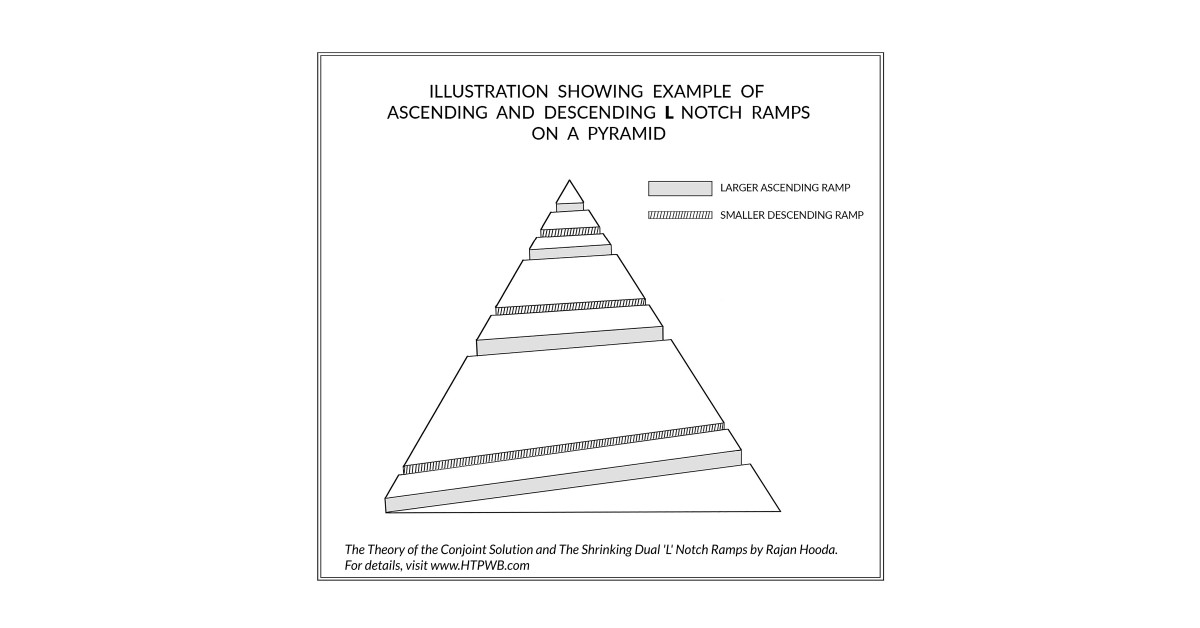[ad_1]
Online, November 26, 2024 (Newswire.com)
–
Indian-American Rajan Hooda, PhD., former McKinsey consultant, Senior Banker and CEO of Alpha Capital Partners, has solved the mystery of how the giant pyramids of Egypt were built after a marathon effort spanning more than 50 years. In his new research paper, Hooda introduces the “Theory of The Conjoint Solution and The Shrinking Dual L Notch Ramps,” a revolutionary approach that offers unprecedented insight into the ancient pyramids’ construction methodology.
The British Museum has one of the world’s most prestigious collections of ancient Egyptian antiquities from the time of the pyramids. Dr. Daniel Antoine, The British Museum’s Head of the Department of Egypt and Sudan, said of Mr. Hooda’s research “…very interesting paper on the construction of the pyramids. Your theory makes a lot of sense…” The 20-page research paper not only proposes a new method of construction but also provides what Mr. Hooda asserts is irrefutable evidence for this ancient engineering feat. The full paper can be downloaded at HTPWB.com, an acronym for “How The Pyramids Were Built.”
Mr. Hooda remembers being captivated as an 8-year-old when he first heard of “one of the great mysteries in the history of mankind – a puzzle unsolved for the past 4,500 years.” He describes his work as “a labor of love and persistence that took me more than 50 years until I was finally able to put the last painstaking pieces of this immense three-dimensional jigsaw puzzle into place.”
Calling the prevailing ideas structurally untenable, such as the use of an exterior ramp, which was larger than the pyramid or a complex interior tunnel ramp, Mr. Hooda’s “L Notch Ramp” is built like a cut-out notch within the footprint of each layer of stones. He theorizes that the pyramid was constructed like a “layer cake” comprising of 210 layers of stones. As he explains, “When the lowest layer of stones was completed, a small portion in one corner was left incomplete to create a small rising ramp from the ground to the top of the first layer – a height of 4.5 feet. This ramp was now used to transport stones needed to build the second layer. Like before, a small part of the second layer was left incomplete to extend the existing ramp from the top of the first layer to the top of the second layer of stones.
“This was now used to transport stones to build the third layer. This process was repeated 209 times until the pyramid was finished. Then, starting from the top, the highest level of the ramp was removed and the missing stones of level 209 were put into place to finish this level. This reverse process of ramp removal and placement of missing stones was repeated 209 times, ending in the lowest level being completed last.” Because the ramp used is not an exterior ramp, nor an interior one, he calls it the “L Notch Ramp” since it is built like a cut-out notch within the footprint of each layer of stones.
Mr. Hooda adds, “The Egyptians would have constructed Dual L Notch Ramps for efficiency, one for taking stones up and a smaller one for workers descending after delivering stones. This method solves the riddle of ramp logistics and since the two ramps were finally removed, there was no evidence left of how the pyramids were built – which is why it remained an enduring mystery for millennia.”
The paper also provides unique evidence of this theory in a never-before recognized aspect of the pyramid – that the smaller stones used at the highest levels was a “forced design compromise” that was a necessary outcome of using the L Notch Ramp method. The upper levels of the pyramids could not have been built without shrinking the width of the ramps to accommodate the smaller footprint of the highest layers of the pyramid. These “Shrinking Ramps” now forced the Egyptians to use smaller stones for the highest levels. Mr. Hooda states, “This very significant compromise in the design symmetry provides the remarkable proof of the method of construction. None of the existing ideas of construction explain or require this design compromise, while for the L Notch Ramps, it is an absolute necessity.” He further explains, “The Shrinking L Notch Ramps and the smaller upper-level stones are two sides of the same coin – a remarkable Conjoint Solution never recognized before. The method of construction of the giant pyramids is literally imprinted in its very design, glaringly visible to the entire world – its greatest secret so boldly hidden in plain sight.”
The new theory also explains why this puzzle remained unsolved for 4,500 years. It identifies eight interlocking components, which together provide irrefutable proof of this integrated theory.
Remarkable Efficiency: No external construction needed.
Genius Simplicity: Requires only simple technology of small ramps.
Innovative L Notch Ramp: A unique dual-purpose interior/exterior design.
Elegant Logistics: Two ramps ensure one-way, efficient transport of stones and labor.
Methodological Invisibility: This technique leaves no evidence of its use/methodology.
Significant Design Compromise: Smaller stones at the top were essential; No other building method requires this compromise.
Shrinking L Notch Ramps: A necessity for the highest levels, forcing the design compromise.
Complete Problem Definition: The Conjoint Solution and The Shrinking Dual L Notch Ramps connect/resolve all the pieces of the pyramids puzzle.
Mr. Hooda emphasizes, “The solution cannot come together from a subset of these components. Since past researchers never recognized many of these components, they never saw the complete puzzle. By attempting to solve only part of the puzzle, the complete puzzle of the pyramid’s construction, as a result, became unsolvable.”
About:
Rajan Hooda, PhD., University of Chicago, M.B.A. IIM, Ahmedabad, has spent more than five decades pursuing his passion for Archaeology and History.
To download the full research paper and learn more, visit HTPWB.com (an acronym for “How The Pyramids Were Built”).
Contact: Email: [email protected] and [email protected]. Phone: +1 914 980 2246
Source: HTPWB.COM
[ad_2]
Source link




